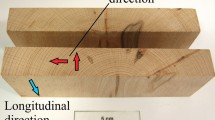Summary
Theoretical models are proposed for predicting the longitudinal and transverse thermal conductivities of wood-polymer composites. The predictions of the models are in good agreement with the measured thermal conductivities of red maple boards impregnated with either polystyrene, polymethyl methacrylate or polyfurfuryl alcohol. The density, heat capacity, transverse thermal conductivity and longitudinal thermal conductivity of the red maple boards were 589 kg/m3,1290 J/kg K, 0.155 W/mK and 0.358 W/mK, respectively. Polymer impregnation moderately altered the thermophysical properties of the boards. The increase in density of the boards ranged from 60% to 79%, the increase in transverse thermal conductivity ranged from 12% to 33%, the increase in longitudinal thermal conductivity ranged from 3% to 13% and the decrease in heat capacity ranged from 3% to 11%. Polystyrene provided the largest increase in density whereas polymethyl methacrylate yielded the greatest increase in thermal conductivity and the largest decrease in heat capacity. Treatment with polyfurfuryl alcohol caused the samples to swell and resulted in the lowest increases in thermal conductivity and density. On average the thermal diffusivity of the composites was 26% smaller than that of the parent wood.
Similar content being viewed by others
Abbreviations
- a:
-
width of air bubble, m
- A:
-
area of WPC sample normal to the heat flow, m2
- b:
-
width of cell cavity, m
- C:
-
coefficient given by Eq. (17)
- Cp:
-
heat capacity, J/kg K
- k:
-
thermal conductivity, W/mK
- l :
-
width of a single wood cell, m
- L:
-
length of WPC sample in direction of heat flow, m
- m:
-
mass, kg
- PFA:
-
polyfurfuryl alcohol
- PMMA:
-
polymethyl methacrylate
- PS:
-
polystyrene
- q:
-
heat flow or heat generated within heater, W
- R:
-
thermal resistance, K/W
- t:
-
time, s
- T:
-
temperature, K
- V:
-
volume, m3
- x:
-
distance from heater, m
- yi :
-
mass fraction of component i in wood-polymer composite
- α:
-
thermal diffusivity (=k/ϱCp)
- β:
-
volumetric expansion factor (=VWPC/VW)
- δ:
-
thickness of cell walls, m
- ɛ:
-
porosity
- ζ:
-
root of Eq. (18)
- λ:
-
length of air bubbles/length of cell lumens
- ϱ:
-
density, kg/m3
- τ:
-
characteristic time given by Eq. (25), s1/2
- a:
-
air
- c:
-
cold
- CW:
-
cell wall
- f:
-
final
- h:
-
hot or heater
- L:
-
longitudinal
- p:
-
polymer
- t:
-
total
- T:
-
transversal
- W:
-
wood
- WPC:
-
wood-polymer composite
- *:
-
under swelled condition
References
Brandrup, J.; Immergut, E. H. (eds.) 1989: Polymer Handbook, 3rd ed., John Willey, New York
Calvet, E.; Prat, H. 1963: Recent Progress in Microcalorimetry. MacMillan, New York
Carslaw, H. S.; Jaeger, J. C. 1959: Conduction of Heat in Solids. 2nd ed., Oxford Univ. Press, Oxford
Chia, L. H. L.; Chua, P. H.; Lee, E. E. N. 1985: A Preliminary study on the Thermal Conductivity and Flammability of WPC based on some Tropical Woods. Radiat. Phys. Chem. 26(4): 423–432
Mathis, N. 1994: The Development of a Probe to Measure Thermal Properties of Isotropic and Anisotropic Materials. PhD Thesis, ChE Dept., Univ. of New Brunswick, Fredericton, N.B., Canada
Mills, A. F. 1992: Heat Transfer, Irwin, Boston.
Schneider, M. H. 1994: Wood Polymer Composites. Wood Fiber Sci. 26(1): 142–151
Siau, J. F.; Davidson, R. W.; Meyer, J. A.; Skaar, C. 1968: A Geometrical Model for Wood-Polymer Composites. Wood Sci. 1(2): 116–128
Siau, J. F. 1969: A Geometrical Model for Thermal Conductivity. Wood and Fiber 1: 302–307
Siau, J. F. 1984: Transport Processes in Wood. Springer-Verlag, New York
Author information
Authors and Affiliations
Additional information
The authors gratefully acknowledge the help of Jonathan Phillips in preparing the wood-polymer composites and on N. Mathis in determining the (KpCp) value of PFA
Rights and permissions
About this article
Cite this article
Couturier, M.F., George, K. & Schneider, M.H. Thermophysical properties of wood-polymer composites. Wood Sci.Technol. 30, 179–196 (1996). https://doi.org/10.1007/BF00231632
Received:
Issue Date:
DOI: https://doi.org/10.1007/BF00231632




